National Geographic expedition leader rates Seychelles ocean, coral health among best in the world
Research |Author: Hajira Amla | March 21, 2015, Saturday @ 09:05| 41895 views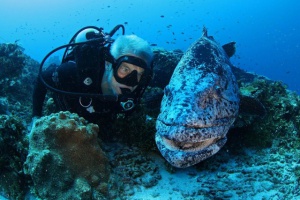
National Geographic's Pristine Seas explorer Paul Rose poses next to a huge Potato Cod in the depths of the waters surrounding the Seychelles' outer islands (Pristine Seas/Manu San Felix)
(Seychelles News Agency) - In September last year, former US President Bill Clinton announced that the 115-island archipelago of Seychelles, located in the western Indian Ocean, would be one of the destinations for the National Geographic Society's Pristine Seas scientific explorations.
Fast forward six months, and the Pristine Seas exploration ship is already hard at work in the waters of the Seychelles, discovering the best this part of the ocean has to offer and getting ready to tell the world all about what they have seen.
SNA conducted a Skype interview with the Pristine Seas' lead explorer, Paul Rose, speaking from the remote Seychelles atoll of Cosmoledo, to find out more about his mission here and what he has discovered so far.
SNA: Is this your first time in the Seychelles?
PR: No, I worked for many years in the Seychelles, running the Shoals of Capricorn programme, and that project was from the Royal Geographical Society, and I’m a former Vice President of the RGS. It was a marine science project we had here in Seychelles, at Sainte Anne, and in Mauritius and at Rodrigues, so I went between the three places. We started it in 1999, and we handed it over to the Seychelles National Parks Authority in 2003.
During that period, I moved the base from Sainte Anne over to Cap Ternay, because of the resort being built there [at Sainte Anne] – I loved it last year when I went back to Sainte Anne and I stayed at the resort. I was so impressed, the way those islands are being managed, the way that the National Park was being managed. The resort is really looking after its reefs - I thought it was a real, tremendous example of how even small marine reserves are effective.
SNA: How does the Pristine Seas programme work and what are its main objectives?
PR: We have three parts to our Pristine Seas project, peer-reviewed science, really top, world-class science, we’ve got a tremendously strong science team from all over the world, highly-regarded, very active and very prolific science paper publishers. So we do the first-class science, and then we put that together with compelling media, you know, we’re a very effective media company, so we can make great films. So we tell the science story with the media, and then the third thing we do is we can influence decision-makers to protect big regions of the sea.
So for instance, in the Pitcairn Islands, which is UK territory, it’s today that we hope that the UK government might make an announcement to protect the Pitcairn Islands [Editor’s note: the United Kingdom did indeed officially announce the creation of the world’s largest marine protected area in the Pitcairn Islands later the same day].
That’s taken many years of work along with our partners. We went out there and did the science, actually it was before my time with Pristine Seas, so the earlier team went to Pitcairn and did all the science, put together a great film, linked it with influencers, and in this case it’s the UK government, and then, by providing the right tools, such as how to tell the story, why it should be protected and all the science behind it, we can help governments make smart decisions.
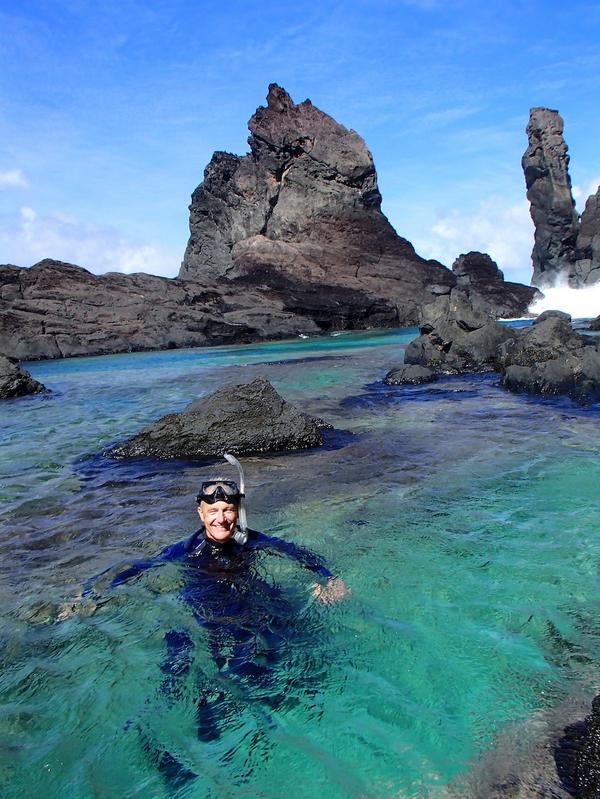 |
| Clearly in his element - UK-born explorer Paul Rose is as at home in the icy waters of the Antarctic as he is pictured in the tropical waters of the volcanic Pitcairn Islands, a British Overseas Territory in the Pacific (Paul Rose/Twitter) Photo License: CC-BY |
We’ve done this the same in all of our previous destinations and you’ll see that we’ve helped to create well over a million square kilometres of marine protected areas.
SNA: How is the Pristine Seas programme involved with the current work being done by the Seychelles government to create the world’s first countrywide Marine Spatial Plan and the $30 million debt-for-nature swap with The Nature Conservancy?
PR: I had a very good meeting with [Finance, Trade and Blue Economy Minister] Jean Paul Adam on the blue economy before we came here… so the blue economy and the whole debt-for-nature swap and the Paris Club decisions all have to be based on science and knowledge of the region, and that’s what we provide, so yes, we’re part of that whole plan. It’s great, the blue economy is a tremendous idea; there aren’t many blue economy departments in governments around the world, so it’s a celebration that Seychelles has one.
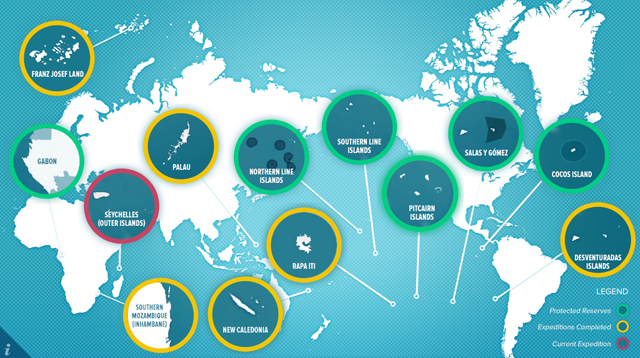 |
| The current expedition to the Seychelles outer islands (marked in red) covers some of the most remote, undisturbed places in the western section of the 115-island archipelago (Pristine Seas) Photo license: CC-BY |
SNA: Where does the funding for these projects come from?
PR: It’s funded mostly through National Geographic core funding, and then certain sponsors look after certain projects as well. We accept funding and philanthropy from various groups that love the ocean. And then our [local] partners in this project are the Island Development Company, the Seychelles Islands Foundation, the Island Conservation Society and the Seychelles National Parks Authority.
SNA: Where are you right now? [Wednesday 18 March]
PR: We’re in Cosmoledo right now, we sailed down from Mahé on the 9th, we went to Assumption first, which was our first main target, and then after a few days we came here to Cosmoledo; this is our last complete day in Cosmoledo. Tomorrow morning we run the short distance to Astove, as you know it’s only 20 miles, so we’ll do that first thing in the morning, then we’ll have two full days at Astove, then we’ll go overnight passage to Aldabra, and then we’ll be on Aldabra [with the Seychelles Islands Foundation, a public trust that manages the Aldabra UNESCO World Heritage Site] until the 26th.
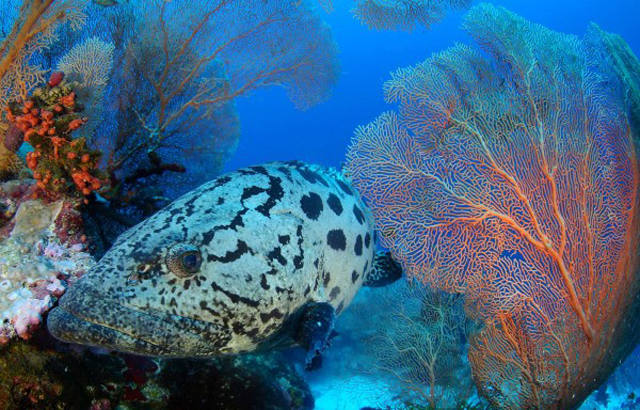 |
| Rose described the Potato Cods in Seychelles as "very social" and almost willing to climb inside the divers' wetsuits (Pristine Seas/Manu San Felix) Photo license: All Rights Reserved |
SNA: How big is your crew and who is responsible for what on this trip?
PR: The Pristine Seas team is 10 and then the crew of the ship is about 12, so we’ve got four people in the main science team, we’ve got three people in the media team, we’ve got Brad, who’s a one-man whirlwind, he runs our deep-cameras, drop-cameras, pelagic cameras and our mini-helicopters for aerial photography. And then there’s me as expedition leader.
SNA: How did you get involved in this kind of work – weren’t you a BBC journalist previously?
PR: I still do BBC work, but I’ve always loved the ocean; I’ve often said that it’s the ocean that defines me. Dr Enric Sala, who is the project leader of Pristine Seas, offered me the opportunity to lead the Pristine Seas expeditions and I have to say, I just jumped at it!
SNA: Do you have any family that is missing you while you are out exploring the ocean?
PR: I’ve got my partner Joelle (she’s Swiss French), but luckily she’s coming… we were in Seychelles together on Sainte Anne Resort last year at this time for 11 days and that was great for me to see my old science site, and I was really delighted with the way it is, that resort. She’s coming on the 27th to join us for a few days and then we’re both going to Silhouette for ten days. I was on Silhouette about four years ago, but Joelle couldn’t come that time, it was just me, I was there on an EarthWatch project, so it’s going to be great for us to share Silhouette together this time.
SNA: What are your initial impressions so far of the Seychelles expedition? How does it compare in terms of marine life and coral health to some of the other places you have been to?
PR: I’d say it’s up there with the world leaders in marine life and coral health – the whole ecosystem is beautiful. Quite obviously the coral bleaching events of 1998 really damaged the marine ecosystem, but the fact is that it’s healthy because it’s recovering. Unhealthy corals and ecosystems that don’t have any resilience do not recover but the Seychelles waters are so healthy that they have a lot of resilience, so it means they can recover.
It’s a beautiful thing; we’ve been really impressed and it’s been exciting, it’s been beautiful. I mean the colour of the waters here… you never see this colour of water anywhere else in the world.
We’re finding the ocean health in great shape... we can obviously see evidence of the bleaching in 1998, but it’s a good thing to see it, because then we know where the baseline is, and then we can see just how well the reefs are recovering. In fact, on one of yesterday’s dives, our chief scientist, Alan, said that he just stopped his work – he was recording fish – he actually stopped his work and just enjoyed it for a while. He rated it as one of his top ten dives in the world. So it’s beautiful and it’s something worth protecting.
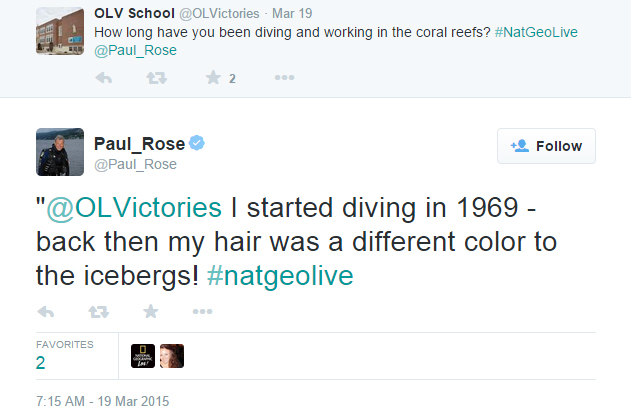 |
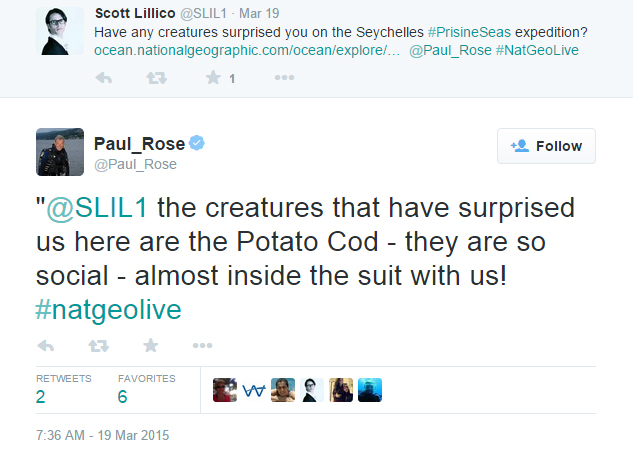 |
| Dozens of questions flowed in for the #NatGeoLive Twitter event held on Thursday 19 March, where Rose answered as many questions as possible from an eager and curious audience (Paul Rose/Twitter) Photo license: CC-BY |
SNA: Did you dive the inner islands at all? Weren’t the inner islands more badly affected by the bleaching event than the outer islands?
PR: We spent a week up at the inner islands, mostly diving Mahé, Praslin, Aride, and the Sainte Anne group, and there of course we can see more damage. It’s shallower water, it got much warmer and of course it’s bound to be less resilient because it also has the pressure of development and fishing and the general busyness of a thriving capital. But even though it’s got those pressures, it is on the way to recovery, which is a great thing.
So yes, we can see the difference between the inner islands and the outer group, of course yes.
SNA: Has your team seen any data regarding the predictions that this year will be an El Nino year and how is that likely to affect the coral reefs?
PR: 2015 is forecast to be a very warm year in the ocean, and of course it makes everybody worried and concerned about what is going to happen, so that’s partly why we’re here at this time, because we can help support and influence the blue economy decision-making, which is a good thing for us, and also it means that we can monitor the marine life before it gets this extra injection of unhealthily hot water. So it’s a great time for us to be here to do this and we just have to keep our fingers crossed… the reefs are healthy, so therefore if they’re healthy, they have got more resilience to lessen the amount of damage, and of course part of that resilience building is managing the fishing properly as well.
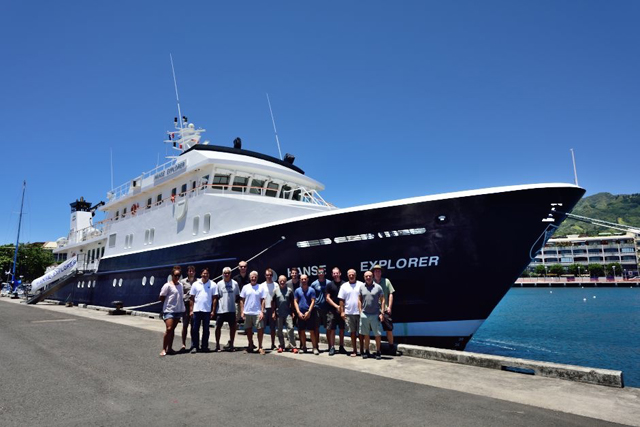 |
| The Pristine Seas team that would explore the French Polynesian island of Rapa stands at the dock in Tahiti with the Hanse Explorer, the vessel that will be their home for the next several weeks. (Pristine Seas/Paul Rose) Photo license: All Rights Reserved |
SNA: What about the hypothesis that the oceans are more resilient than we give them credit for and that corals around the world are beginning to show signs of being able to adapt to higher temperatures?
PR: It’s a good question - there’s always hope where the ocean is concerned, because it’s such a powerful, energetic system, and let’s face it, it’s the largest and least understood ecosystem on the planet, so we’re always learning, but one thing we know for sure is that there are regions where it has warmed up a lot, and yet the coral is thriving – I was working in Eritrea just a few years ago and the corals there are well into the thirties, but they’re doing really well, so we’ve been studying those to see how they pick up a new algal partner.
But when they’re adapting, they don’t adapt overnight, so that’s the real worry. If the corals are left alone and they just have to adapt to temperature, that’s easy, because they probably will adapt, but as they adapt some will die off and different versions will come up, and the whole ecosystem would continue, but if during the stress of temperature change, then the corals receive other stresses, such as overfishing or pollution or ocean acidification, then the chances are that the corals won’t recover, so it all has to be handled in a holistic way, obviously.
SNA: Have you got any data to share so far on microplastics in the water?
PR: We’re collecting water samples, and we know that there will be microplastics in there, but we haven’t analysed them yet, we can’t analyse them until we get back. It’s something we’re acutely aware of because all of the plastic that we’ve foolishly dumped in the sea doesn’t just disappear, when it breaks down and breaks down again it becomes micro-pollutants and they get in the food chain, it gets in the fish and birds eat the fish, the birds eat the tiny plastic chips thinking they are fish eggs, and some plastics, once they have become small and break down a little bit they become almost like toxic magnets, and attract even more toxins to themselves. So the plastic situation in the sea is a true disaster.
I’m very much hoping that we’ll get on top of it now because we’ve stopped putting so much in as we used to; the level of awareness is much higher than it ever used to be, but that’s why part of our monitoring includes microplastics. When we send the report to the Seychelles government it will include our microplastics report.
SNA: The Island Conservation Society has previously raised concerns about the effect of the tuna industry’s Fish Aggregation Devices (FADs) washing up on the islands and endangering marine life – have you come across any while you have been out there?
PR: We have – nearly every beach we’ve been on, we’ve found FADs. They use thousands of these things, and the reason they use them is because they make very effective fishing devices, but it’s a disaster and it all becomes part of this overfishing system that’s very unsustainable. On the beaches that we go to, we find complete FADs or bits and pieces of them all over the place.
SNA: Have you seen anything interesting from the drop-cameras yet?
PR: Well, the thing with the drop-cams is that you never can tell. We put them as far out as possible, in 1,200 to 1,400 metres deep at the moment. They have been to the bottom of the Mariana Trench, which is the deepest part of the ocean, but for operational reasons it’s easier getting them to around 1,300 metres for this part of the project, but we haven’t seen much yet. We never know, because once they’re in the water, we can only move them a little bit, we have a little hopper that pops them up off the bottom and they drift along on the current and drop down again. So it’s early days yet, but we always get something exciting from the drop-cameras.
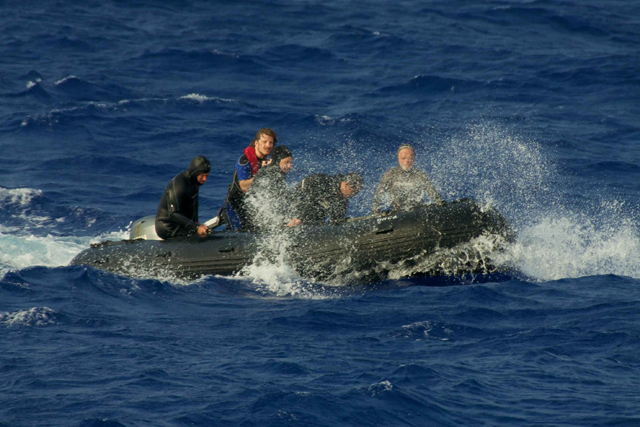 |
| The Pristine Seas diving team head back to the boat in rough seas after a dive in the treacherous waters around the French Polynesian island of Rapa (Pristine Seas/David Tickler) Photo license: All Rights Reserved |
SNA: Can you explain a little bit more about the sound recordings you are doing here?
PR: What we’re doing is recording just how much noise there is in the ocean, that there is just a vast amount of noise in the ocean. As you know, sound travels so well underwater, and there’s so much that’s unknown. The jury is out at the moment as to how much it actually affects marine life, but it stands to reason that it’s got to have an impact.
Certainly, part of the navigation system for all marine life is sound, and you only have to be on a reef using scuba diving gear, and when you exhale, half the fish jump, so you can imagine what it is for them when they hear seismic booms and all the noise from commercial shipping, so we’re contributing to that research but we don’t have any definitive summary of the acoustic research yet, but we will have.
Adding the sound recordings is new for us, we’ve only just added it to our suite of science, but we’re pretty quick with our results, we’ve got good partners – in this case, we’re partnering with St Andrews [University] in Scotland and of course SIF, so we’ll do our best to get the quick results out as soon as possible.
SNA: So you’ll be arriving back in Mahé for a post-expedition conference?
PR: On the 27th, we fly off Assumption Island back to Mahé, and we land to present our conference as people fresh from the ocean, which is always a good thing. People are generally usually surprised that we can land on the dock with our initial scientific results complete and ready to present, which we will do, with a very short version of our main film, a few minutes of film, images and reports from the expedition in a really organised way.
In the old days expeditions returned to the docks and spent ten years writing up their stuff. We spend some time preparing the science for publishing, but we are able to come ashore with our initial results, film and images, so that’s what the conference is all about, and we need to share it with our partners – we’ve got partners that we were working with that can’t be here on the expedition, such as the Island Development Company, the Seychelles Islands Foundation the Island Conservation Society.
We love the end-of-expedition conference and receptions, they’re only a couple of hours long, and we meet all of the people that have followed and helped us and partnered with us.
Back
